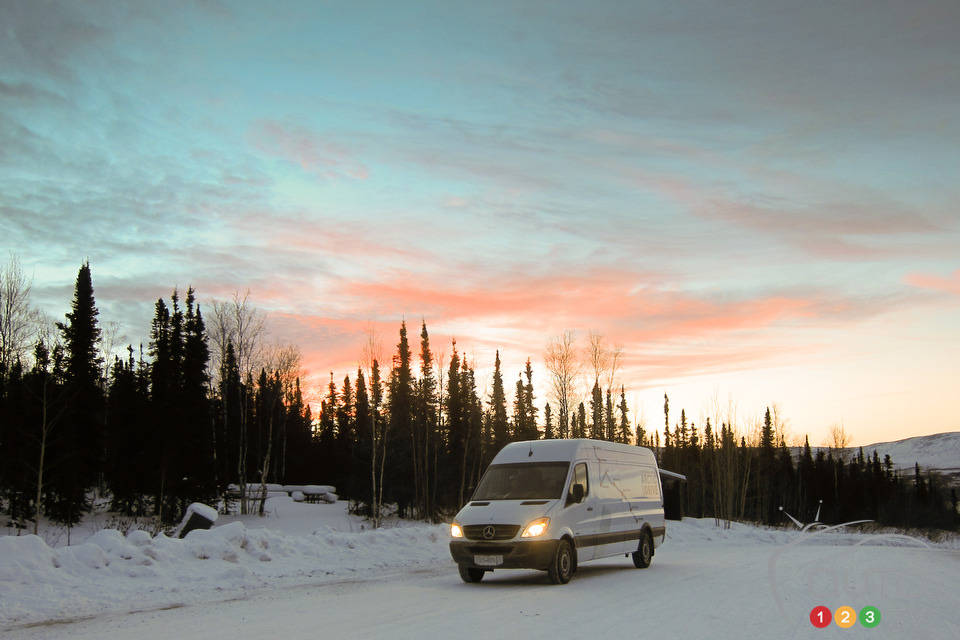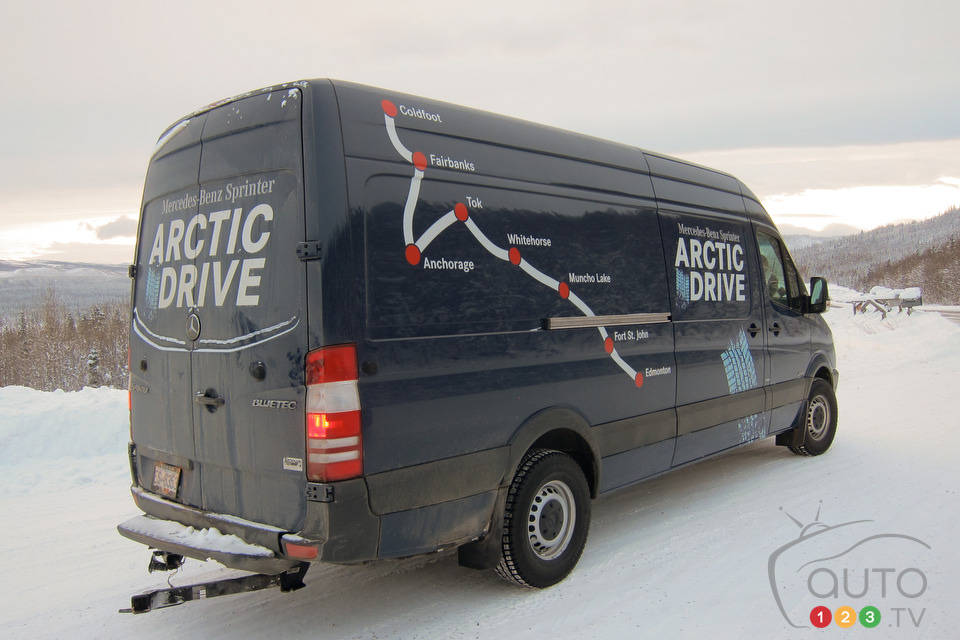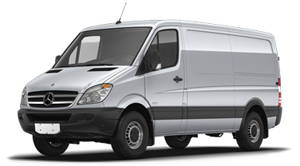Cold-weather testing in one of the harshest environments on earth
COLDFOOT, Alaska -- The temperature gauge on my Sprinter van is flashing, as if in celebration, as it registers +85 degrees Celsius.
No, we haven't experienced some catastrophic warming of the polar ice caps. The display can only register temps down to -40 degrees Celsius
We're subjecting ourselves, and our convoy of nine Mercedes-Benz Sprinter vans, to one of the harshest environments on the planet in order to prove (or disprove) the vehicle's suitability in cold weather. The final leg of a 5,300 km journey that began in Edmonton, Alberta, our drive would carry us through 1,972 km of remote wilderness, far past the Arctic Circle.
Increasing competition in the commercial van segment
For many years, one of the most successful commercial vehicles in Europe (the Mercedes-Benz Sprinter) was a bit of an oddity when it arrived in North America a little over a decade ago. Sold as a Dodge during the Daimler-Chrysler years, it's worn the Mercedes badge since 2010.
The commercial van segment has taken off, with entries from Nissan, Chrysler and Ford heating up the competition. Businesses count on their work trucks to be reliable, and for an extreme climate like this a vehicle's got to be really tough.
Mercedes had conducted some cold-weather testing in Sweden with the Sprinter, but "only" to -30 degrees Celcius.
The 2013 Mercedes-Benz Sprinters are powered by 3.0L BlueTech diesel engines. And diesel (unlike gasoline, which remains a liquid until -45) can start to crystallize once the temperature dips below zero. Special anti-gel agents have been added to the fuel to prevent this, but diesel also ignites through compression rather than spark, which can be almost impossible if the engine block freezes. Our Sprinters are equipped with diesel pre-heaters, which can be set to come on roughly half an hour before start-up.
Perilous mountain passes test the traction control system
Our convoy is made up of two passenger vans, and the rest are long- & short-wheelbase cargo vans. We dub our short white cargo van "Norge" not only in honour of the first airship that flew over the North Pole in 1926, but for its resemblance to a big, white refrigerator. It's surprisingly comfortable and features multiple cubbies and storage shelves (even above the visor -- brilliant).
A rear-wheel-drive unladen truck on the Dalton Highway to Coldfoot, Alaska -- one of the world's toughest roads featuring steep mountain passes -- probably sounds like a recipe for disaster.
However, the 2013 Mercedes-Benz Sprinter's traction-control system showed off what a fine piece of engineering it is -- aided by Continental snow tires. Most of the time we're travelling on solid ice; there is some traction because it's too cold for the thin layer of moisture that usually sits upon the surface, and the ice has been chewed up by the plows that occasionally pass by.
Extreme cold snap presents challenges
Our first day passes by with little drama. We're still in relative civilization, and although we've crossed mountains, it's nothing too out of the ordinary.
However, the morning in Fairbanks brings with it the Arctic cold we've been nervously anticipating. We move about the parking lot enveloped in swirling clouds of ice fog. The 2013 Mercedes-Benz Sprinters are reluctant to start, and with batteries operating at about 10% of their capacity in the bitter cold, a few need a boost to get going. Unfortunately, the pre-heater wasn't activated on one of the vans, and despite numerous attempts to start it we reluctantly had to leave it behind.
The 2013 Mercedes-Benz Sprinter's output is 188 hp with 325 lb-ft of torque, which gets the big vehicle (3,876 - 5,003 kg) moving smartly if not with a blinding top speed. Steering is surprisingly good for such a big truck -- at least until the mercury got below -40.
As the power steering and transmission fluids got colder, and thus more viscous, we discovered that steering became quite stiff at slow speeds, and occasionally the transmissions were reluctant to shift. After Fairbanks, we decided to leave the vehicles running all night, which alleviated the start-up worry and helped keep the vehicles warm.
We averaged 12.6L in Norge, our short-wheelbase van.
Crossing the steep Brooks mountain range, we used the manual shift option to gear down the 5-speed automatic and other than a slight skittishness by the short-wheelbase cargo vans, our 2013 Mercedes-Benz Sprinters handled the slick roads admirably.
We, and the Sprinters, survive a rite of passage
We rejoiced upon reaching the remote outpost of Coldfoot in our 2013 Mercedes-Benz Sprinters as though we passed some frontier rite of passage. Though enduring some of the most brutal cold imaginable, we'd also been struck by the vast and remote beauty of this wild and lonely place. A more suitable test of cold weather endurance would be hard to imagine.
COLDFOOT, Alaska -- The temperature gauge on my Sprinter van is flashing, as if in celebration, as it registers +85 degrees Celsius.
No, we haven't experienced some catastrophic warming of the polar ice caps. The display can only register temps down to -40 degrees Celsius
We're subjecting ourselves, and our convoy of nine Mercedes-Benz Sprinter vans, to one of the harshest environments on the planet in order to prove (or disprove) the vehicle's suitability in cold weather. The final leg of a 5,300 km journey that began in Edmonton, Alberta, our drive would carry us through 1,972 km of remote wilderness, far past the Arctic Circle.
Increasing competition in the commercial van segment
For many years, one of the most successful commercial vehicles in Europe (the Mercedes-Benz Sprinter) was a bit of an oddity when it arrived in North America a little over a decade ago. Sold as a Dodge during the Daimler-Chrysler years, it's worn the Mercedes badge since 2010.
The commercial van segment has taken off, with entries from Nissan, Chrysler and Ford heating up the competition. Businesses count on their work trucks to be reliable, and for an extreme climate like this a vehicle's got to be really tough.
Mercedes had conducted some cold-weather testing in Sweden with the Sprinter, but "only" to -30 degrees Celcius.
The 2013 Mercedes-Benz Sprinters are powered by 3.0L BlueTech diesel engines. And diesel (unlike gasoline, which remains a liquid until -45) can start to crystallize once the temperature dips below zero. Special anti-gel agents have been added to the fuel to prevent this, but diesel also ignites through compression rather than spark, which can be almost impossible if the engine block freezes. Our Sprinters are equipped with diesel pre-heaters, which can be set to come on roughly half an hour before start-up.
Perilous mountain passes test the traction control system
Our convoy is made up of two passenger vans, and the rest are long- & short-wheelbase cargo vans. We dub our short white cargo van "Norge" not only in honour of the first airship that flew over the North Pole in 1926, but for its resemblance to a big, white refrigerator. It's surprisingly comfortable and features multiple cubbies and storage shelves (even above the visor -- brilliant).
A rear-wheel-drive unladen truck on the Dalton Highway to Coldfoot, Alaska -- one of the world's toughest roads featuring steep mountain passes -- probably sounds like a recipe for disaster.
However, the 2013 Mercedes-Benz Sprinter's traction-control system showed off what a fine piece of engineering it is -- aided by Continental snow tires. Most of the time we're travelling on solid ice; there is some traction because it's too cold for the thin layer of moisture that usually sits upon the surface, and the ice has been chewed up by the plows that occasionally pass by.
Extreme cold snap presents challenges
Our first day passes by with little drama. We're still in relative civilization, and although we've crossed mountains, it's nothing too out of the ordinary.
However, the morning in Fairbanks brings with it the Arctic cold we've been nervously anticipating. We move about the parking lot enveloped in swirling clouds of ice fog. The 2013 Mercedes-Benz Sprinters are reluctant to start, and with batteries operating at about 10% of their capacity in the bitter cold, a few need a boost to get going. Unfortunately, the pre-heater wasn't activated on one of the vans, and despite numerous attempts to start it we reluctantly had to leave it behind.
The 2013 Mercedes-Benz Sprinter's output is 188 hp with 325 lb-ft of torque, which gets the big vehicle (3,876 - 5,003 kg) moving smartly if not with a blinding top speed. Steering is surprisingly good for such a big truck -- at least until the mercury got below -40.
As the power steering and transmission fluids got colder, and thus more viscous, we discovered that steering became quite stiff at slow speeds, and occasionally the transmissions were reluctant to shift. After Fairbanks, we decided to leave the vehicles running all night, which alleviated the start-up worry and helped keep the vehicles warm.
We averaged 12.6L in Norge, our short-wheelbase van.
Crossing the steep Brooks mountain range, we used the manual shift option to gear down the 5-speed automatic and other than a slight skittishness by the short-wheelbase cargo vans, our 2013 Mercedes-Benz Sprinters handled the slick roads admirably.
We, and the Sprinters, survive a rite of passage
We rejoiced upon reaching the remote outpost of Coldfoot in our 2013 Mercedes-Benz Sprinters as though we passed some frontier rite of passage. Though enduring some of the most brutal cold imaginable, we'd also been struck by the vast and remote beauty of this wild and lonely place. A more suitable test of cold weather endurance would be hard to imagine.
Road Tests and Reviews
Experts
Consumers
2013 Mercedes Sprinter




Article Gallery



